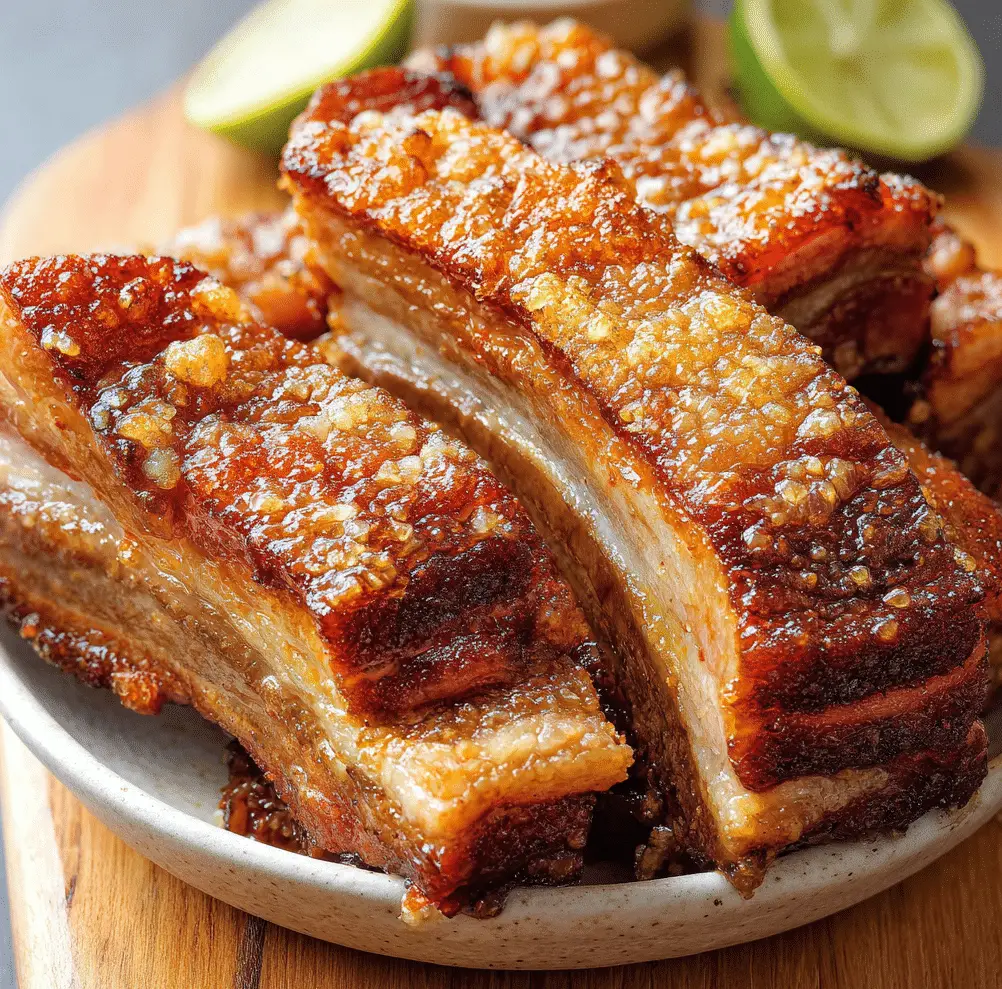The magic of Colombian cuisine comes alive in this crispy, golden pork belly dish known as Chicharrón. Simmered until tender, then fried to perfection, this recipe delivers that unbeatable crunchy bite followed by melt-in-your-mouth richness. The pork skin crackles with flavor while the rendered fat keeps the meat juicy and savory.
Traditionally served with lime wedges and corn arepas, this dish is a favorite in Colombian households and a popular street food across the country. Whether you’re throwing a weekend gathering or treating yourself to a comfort meal, this pork belly is a celebration of culture and indulgent flavor. Once you try it, you’ll be hooked on its crackly, juicy goodness.
Full Recipe
Ingredients:
-
2 pounds pork belly, skin on
-
1 tablespoon baking soda
-
2 teaspoons salt
-
2 cups water
-
Oil for frying (enough to submerge pork belly)
-
Lime wedges, for serving
-
Optional: Colombian arepas or white rice
Directions:
-
Rinse pork belly and pat dry. Cut into thick strips, about 1-inch wide.
-
In a large bowl, rub the pork belly pieces with salt and baking soda. Let sit for 20 minutes.
-
Place pork belly pieces in a pot with 2 cups water. Bring to a boil over medium-high heat.
-
Cover partially and simmer for 30–40 minutes until water mostly evaporates and pork is tender.
-
Remove the lid and continue cooking until the remaining water evaporates and the fat begins to render.
-
Once fat has rendered and pork starts to brown, remove pieces and pat dry.
-
In a deep fryer or heavy pot, heat oil to 375°F (190°C). Fry pork belly in batches until golden brown and crispy, about 5–7 minutes.
-
Drain on paper towels. Serve hot with lime wedges and traditional sides like arepas or white rice.
Prep Time: 15 minutes | Cooking Time: 1 hour | Total Time: 1 hour 15 minutes
Kcal: 420 kcal per serving | Servings: 4 servings
The Rich Tradition of Colombian-Style Pork Belly
Colombian-Style Pork Belly, or Chicharrón Colombiano, is more than just a popular dish—it’s a cultural staple deeply rooted in Colombian culinary tradition. Found in humble kitchens and bustling street food stalls alike, this crispy, golden delight represents comfort food at its finest. Characterized by its perfectly crisp exterior and succulent, fatty interior, this dish offers both a textural and flavorful experience that’s second to none.
Historically, pork has been a central protein in many Latin American countries due to its availability and versatility. In Colombia, chicharrón plays a pivotal role in meals throughout the Antioquia region and beyond. Often served as part of a traditional bandeja paisa (a hearty platter also featuring beans, rice, avocado, egg, and more), it stands tall as one of the most iconic representations of Colombian cuisine. The cooking process, involving slow simmering followed by high-heat frying, allows the natural fats in the pork belly to render down, ensuring that every bite is juicy inside and gloriously crispy on the outside.
Cultural Importance in Colombia
Chicharrón is not just a dish—it’s an experience and a symbol of Colombian heritage. It’s commonly featured during weekend family gatherings, street festivals, and national celebrations. Each household has its own approach, some adding vinegar or spices, others keeping it simple with salt and lime. In Colombian culture, cooking and sharing chicharrón often reflects generosity and celebration.
Furthermore, this pork belly preparation highlights the broader Latin American tradition of nose-to-tail eating, where every part of the animal is respected and used. In rural communities, where preserving meat through frying has historical significance, dishes like chicharrón were essential. Today, they remain beloved not only for their practicality but also for their nostalgic value.
Texture, Flavor, and Sensory Experience
What makes Colombian-style pork belly truly irresistible is the way its textures and flavors harmonize. When done right, the pork belly achieves three distinct layers: an ultra-crispy skin that shatters with every bite, a rich and fatty layer that melts on the tongue, and a firm yet tender meat layer that holds it all together. The initial preparation of simmering the pork pieces helps to soften the meat and render out some of the fat, while the final deep-frying ensures a blistered, crunchy exterior.
This contrast between crispy and juicy is key to why chicharrón is so universally satisfying. Add a squeeze of lime over the top, and the zesty acidity cuts through the fat beautifully, balancing richness with brightness.
Serving Suggestions and Pairings
Colombian chicharrón is traditionally served with accompaniments that reflect the rustic and hearty nature of the dish. Arepas, the beloved cornmeal cakes of Colombia, are a popular choice. Their soft interior and slight chewiness make them a perfect match for crispy pork belly. Some prefer to serve chicharrón over white rice with slices of avocado, fried plantains (patacones or maduros), and a side of fresh tomato and onion sauce called hogao.
In the context of the famed bandeja paisa, the chicharrón shares the plate with a fried egg, red beans, ground beef, sweet plantains, avocado, and an arepa. This combination is not for the faint of heart—it’s a feast designed to satisfy even the most robust appetites.
For beverages, a cold beer or a refreshing glass of limeade (limonada) complements the richness of the dish. If you’re seeking a traditional Colombian drink, aguapanela—a sweetened water made from unrefined cane sugar—is another great option.
Modern Takes and Global Appeal
While the traditional preparation of Colombian-style pork belly remains sacred, modern chefs and home cooks are experimenting with new techniques and flavors. Some roast the pork belly in the oven or air fryer to reduce oil usage, while others infuse it with garlic, chili, or citrus marinades for an extra burst of flavor. In fine dining circles, you might even find chicharrón served alongside gourmet sauces or atop modern fusion dishes.
Globally, chicharrón has become increasingly popular beyond Colombian borders. Food lovers in the U.S., Europe, and Asia are discovering the appeal of this crispy delicacy, often served as tapas, bar snacks, or even taco fillings. Its rise in popularity mirrors a broader appreciation for traditional foods that focus on simplicity, authenticity, and bold flavors.
Health Considerations and Cooking Tips
While undeniably indulgent, Colombian-style pork belly can be enjoyed in moderation as part of a balanced diet. Since it’s high in fat, portion control is important. Pairing it with fiber-rich sides like beans or vegetables can help offset the richness.
For those cooking it at home, choosing the right cut is essential. Look for pork belly with a good balance of meat and fat, and always make sure the skin is intact if you’re aiming for maximum crispiness. A key cooking tip: allow the pork belly to dry thoroughly before frying to avoid dangerous splatter and to encourage proper crisping. Resting the meat post-frying also helps reabsorb some of the flavorful juices and keeps the texture ideal.
If deep-frying isn’t your preference, oven-roasting the simmered pork belly at a high temperature (around 450°F) can also yield deliciously crispy skin with less mess.
Why This Recipe Stands Out
Among the many ways pork belly is prepared around the world, the Colombian version stands out for its unique combination of slow-simmered tenderness and deep-fried crunch. It reflects the ingenuity of home cooks who, for generations, found ways to elevate a humble cut of meat into something special. The result is a dish that’s packed with flavor, satisfying in every bite, and steeped in history.
Another point of distinction is the presentation. Unlike thin cracklings or pork rinds found in other cuisines, Colombian chicharrón is served in thick, hearty pieces that offer a true meaty bite. It feels substantial and celebratory—a dish that invites conversation and sharing.
Conclusion: More Than Just a Crispy Bite
Colombian-style pork belly isn’t just about the food on the plate—it’s about tradition, family, and the celebration of flavors that speak to generations of cooks and eaters. It’s rustic yet refined, indulgent yet rooted in simplicity. Whether you’re preparing it as a tribute to your heritage or discovering it for the first time, chicharrón delivers a culinary experience that goes beyond the crunch.
This dish represents everything we love about comfort food: a rich history, a deeply satisfying flavor, and a sensory experience that lingers long after the last bite. If you’re looking to bring a little taste of Colombia to your kitchen, this pork belly recipe is the perfect place to start.






